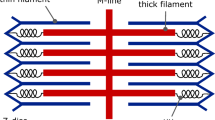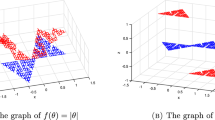Abstract
We studied mathematical models for the length distributions of actin filaments under the effects of polymerization/depolymerization, and fragmentation. In this paper, we emphasize the effects of these two processes acting alone. In this case, simple discrete and continuous models can be derived and solved explicitly (in several special cases), making the problem interesting from a modeling and pedagogical point of view. In a companion paper (Ermentrout and Edelstein-Keshet, 1998, Bull. Math. Biol. 60, 477–503) we investigate what happens when the processes act together, with particular attention to fragmentation by gelsolin, and with a greater level of biological detail.
Similar content being viewed by others
References
Aizawa, H., K. Sutoh and I. Yahara (1996). Overexpression of cofilin stimulates bundling of actin filaments, membrane ruffling, and cell movement in dictyostelium. J. Cell Biol. 132, 335–344.
Alberts, B., D. Bray, J. Lewis, M. Raff, K. Roberts and J. D. Watson (1989). Molecular Biology of the Cell, 2nd edn, New York: Garland.
Bonder, E. M., D. J. Fishkind and M. S. Mooseker (1983). Direct measurement of critical concentrations and assembly rate constants at the two ends of an actin filament. Cell 34, 491–501.
Brenner, S. L. and E. D. Korn (1983). On the mechanism of actin monomer-polymer subunit exchange at steady state. J. Biol. Chem. 258, 5013–5020.
Cano, M. L., L. Cassimeris, M. Fechheimer and S. H. Zigmond (1992). Mechanisms responsible for F-actin stabilization after lysis of polymorphonuclear leukocytes. J. Cell Biol. 116, 1123–1134.
Cano, M. L., D. A. Lauffenburger and S. H. Zigmond (1991). Kinetic analysis of F-actin depolymerization in polymorphonuclear leukocyte lysates indicates that chemoattractant stimulation increases actin filament number without altering the filament length distribution. J. Cell. Biol. 115, 677–687.
Coluccio, L. M. and L. G. Tilney (1983). Under physiological conditions actin disassembles slowly from the nonpreferred end of an actin filament. J. Cell Biol. 97, 1629–1634.
Cooper, J. A. (1991). The role of actin polymerization in cell motility. Ann. Rev. Physiol. 53, 585–605.
Coppin, C. M. and P. Leavis (1992). Quantitation of liquid-crystaline ordering in F-actin solutions. Biophys. J. 63, 794–807.
Doi, M. and S. F. Edwards (1986). The Theory of Polymer Dynamics, Oxford: Clarendon Press.
Edelstein-Keshet, L. (1988). Mathematical Models in Biology, New York: McGraw-Hill.
Edelstein-Keshet, L. and G. B. Ermentrout (1998). Spatially explicit models for actin filament polymerization, (in press).
Ermentrout, G. B. and L. Edelstein-Keshet (1998). Models for the Length distribution of actin filaments: II. Polymerization and Fragmentation by Gelsolin acting together. Bull. Math. Biol. 60, 477–503.
Fesce, R., F. Benfenati, P. Greengard and F. Valtorta (1992). Effects of the neuronal phosphoprotein synaptin I on actin polymerization: I. Analytic interpretation of kinetic curves. J. Biol. Chem. 267, 11289–11299.
Fiedler, M. (1986). Special Matrices and Their Applications in Numerical Mathematics, Boston: Martinus Hijhoff.
Frieden, C. (1983). Polymerization of actin: mechanism of the Mg2+-induced process at pH 8 and 20 °C. Proc. Natl. Acad. Sci. USA 80, 6513–6517.
Furukawa, R., R. Kundra and M. Fechheimer (1993). Formation of liquid crystals from actin filaments. Biochemistry 32, 12346–12352.
Hartwig, J. H. and D. J. Kwiatkowski (1991). Actin binding proteins. Curr. Opin. Cell Biol. 3, 87–97.
Hawkins, M., B. Pope, S. K. Maciver and A. G. Weeds (1993). Human actin depolymerizing factor mediates a pH-sensitive destruction of actin filaments. Biochemistry 32, 9985–9993.
Hayden, S. M., P. Miller, A. Brauweiler and J. R. Bamburg (1993). Analysis of the interactions of actin depolymerizing factor with G-and F-actin. Biochemistry 32, 9994–10004.
Horn, R. A. and C. R. Johnson (1985). Matrix Analysis, Cambridge: Cambridge University Press.
Houmeida, A., R. Bennes, Y. Benyamin and C. Roustan (1995). Sequences of actin implicated in the poymerization process: a simplified mathematical approach to probe the role of these segments. Biophys. Chem. 56, 201–214.
Janmey, P. A., S. Hvidt, J. Kas, D. Lerche, A. Maggs, E. Sackmann, M. Schliwa and T. Stossel (1994). The mechanical properties of actin gels. J. Biol. Chem. 269, 32503–32513.
Janmey, P. A. and P. T. Matsudaira (1988). Functional comparison of vilin and gelsolin. J. Biol. Chem. 263, 16738–16743.
Janmey, P. A., J. Peetermans, K. S. Zaner, T. P. Stossel and T. Tanaka (1986). Structure and mobility of actin filaments as measured by quasielectric light scattering, viscometry and electron microscopy. J. Biol. Chem. 261, 8357–8362.
Kas, J., H. Strey, J. X. Tang, D. Finger, R. Ezzell, E. Sackmann, and P. A. Janmey (1996). F-actin, a model polymer for semiflexible chains in dilute, semidilute, and liquid crystaline solutions. Biophys. J. 70, 609–625.
Kawamura, M. and K. Maruyama (1970). Electron microscopic particle length of F-actin polymerized in vitro. J. Biochem 67, 437–457.
Kirschner, M. W. (1980). Implications of treadmilling for the stability and polarity of actin and tubulin polymers in vivo. J. Cell Biol. 86, 330–334.
Korn, E. D., M. Carlier and D. Pantaloni (1987). Actin polymerization and ATP hydrolysis. Science 238, 638–644.
Lauffenburger, D. A. and A. F. Horowitz (1996). Cell migration: a physically integrated molecular process. Cell 84, 359–369.
Lumsden, C. J. and P. A. Dufort (1993). Cellular automaton model of the actin cytoskeleton. Cell Motil. Cytoskel. 25, 87–104.
Maciver, S. K., H. G. Zot and T. D. Pollard (1991). Characterization of actin filament severing by actophorin from Acanthamoeba castellanii. J. Cell. Biol. 115, 1611–1620.
Marchand, J., P. Moreau, A. Paoletti, P. Cossart, M. Carlier and D. Pantaloni (1995). Actin-based movement of Listeria monocytogenes: actin assembly results from the local maintenance of uncapped filament barbed ends at the bacterium surface. J. Cell Biol. 130, 331–343.
Mitchison, T. J. and L. Cramer (1996). Actin-based cell motility and cell locomotion. Cell 84, 371–379.
Mogilner, A. and G. Oster (1996). Cell motility driven by actin polymerization. Biophys. J. 71, 3030–3045.
Moon, A. and D. G. Drubin (1995). The ADF/cofilin proteins: stimulus-responsive modulators of actin dynamics. Mol. Biol. Cell 6, 1423–1431.
Oosawa, F. and M. Kasai (1962). A theory of linear and helical aggregations of macromolecules. J. Mol. Biol. 4, 10–21.
Oster, G. F. (1994). Biophysics of Cell Motility, Lecture Notes, Berkeley, University of California.
Podolski, J. L. and T. L. Steck (1990). Length distributions of F-actin in Dictyostelium discoideum. J. Biol. Chem. 265, 1312–1318.
Pollard, T. D. (1986). Rate constants for the reactions of ATP-and ADP-actin with the ends of actin filaments. J. Cell Biol. 103, 2747–2754.
Pollard, T. D. and M. S. Mooseker (1981). Direct measurement of actin polymerization rate constants by electron microscopy of actin filaments nucleated by isolated microvillus cores. J. Cell Biol. 88, 654–659.
Redmond, T. and S. H. Zigmond (1993). Distribution of F-actin elongation sites in lysed polymorphonuclear leukocytes parallels the distribution of endogenous F-actin. Cell Motil. Cytoskel. 26, 1–18.
Sechi, A., J. Wehland and J. V. Small (1996). Actin filament organization in isolated comet tails of Listeria monocytogenes: The molecular basis of cell locomotion. 13th Harden Discussion Meeting, Wye College, England.
Selve, N. and A. Wegner (1986). Rate of treadmilling of actin filaments in vitro. J. Mol. Biol. 187, 627–631.
Sun, H. Q., K. Kwiatkowska and H. L. Yin (1996). Beta-thymosins are not simple actin monomer buffering proteins. Insights from overexpression studies. J. Biol. Chem. 271, 9223–9230.
Suzuki, A., T. Maeda and T. Ito (1991). Formation of liquid crystalline phase of actin filament solutions and its dependence on filament length as studied by optical birefringence. Biophys J. 59, 25–30.
Theriot, J. A. (1994). Actin filament dynamics in cell motility, in Actin:Biophysics, Biochemistry, and Cell Biology, J. E. Estes and P. J. Higgins (Eds), New York: Plenum Press, pp. 133–145.
Tobacman, L. S. and E. D. Korn (1983). The kinetics of actin nucleation and polymerization, J. Biol. Chem. 258, 3207–3214.
Wachsstock, D. H., W. H. Schwarz and T. D. Pollard (1993). Affinity of α-actinin for actin determines the structure and mechanical properties of actin filament gels. Biophys. J. 65, 205–214.
Wachsstock, D. H., W. H. Schwarz and T. D. Pollard (1994). Cross-linker dynamics determine the mechanical properties of actin gels. Biophys. J. 66, 801–809.
Wegner, A. and J. Engel (1975). Kinetics of cooperative association of actin to actin filaments. Biophys. Chem. 3, 215–225.
Zaner, K. S. (1995). Physics of actin networks. I. Rheology of semi-dilute F-actin. Biophys. J. 68, 1019–1026.
Zigmond, S. H. (1993). Recent quantitative studies of actin filament turnover during cell locomotion. Cell Motil. Cytoskel. 25, 309–316.
Author information
Authors and Affiliations
Rights and permissions
About this article
Cite this article
Edelstein-Keshet, L., Ermentrout, G.B. Models for the length distributions of actin filaments: I. Simple polymerization and fragmentation. Bull. Math. Biol. 60, 449–475 (1998). https://doi.org/10.1006/bulm.1997.0011
Received:
Accepted:
Issue Date:
DOI: https://doi.org/10.1006/bulm.1997.0011




